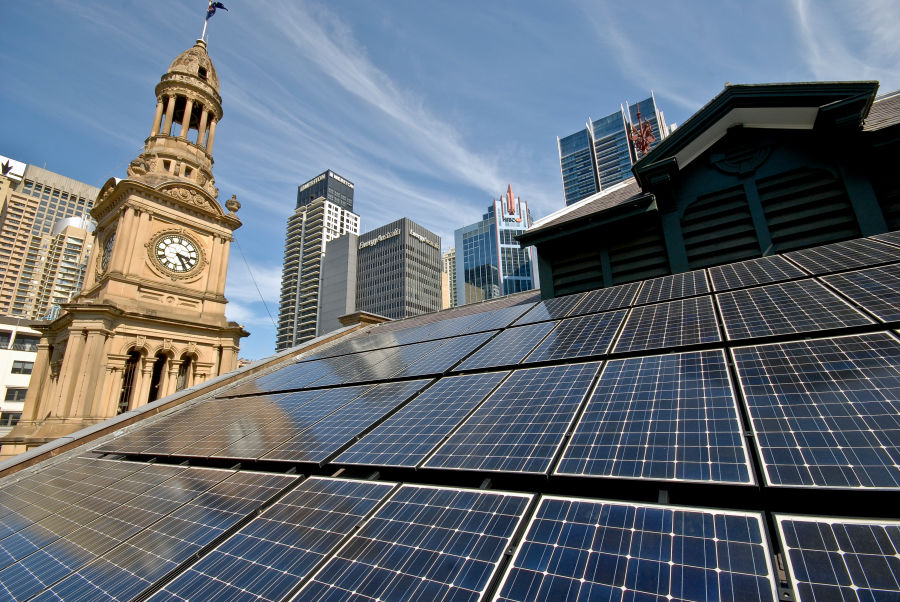While thus far the state of New South Wales has not taken determined steps towards energy transition, such as introducing a renewable energy target or making a plan to replace its ageing and unreliable coal power stations, Sydney has set an ambitious goal to further slash its greenhouse gas emissions by using 100% renewables to meet its electricity needs.
Having increased its 2030 renewable electricity target from 50% to 100%, the City of Sydney said it would preference purchasing renewable power from community-generated sources in pursuit of the target. It plans to purchase renewable energy generated by wind or solar PV to power its larger sites, like pools and libraries, and offset the carbon emissions in the electricity used at small sites.
“Acting on climate change is the City’s top priority. We were among the first to set science-based targets in 2008 and since then we’ve reduced our emissions by 20% on 2005 levels,” said Lord Mayor Clover Moore. “This decision by Council will allow us to achieve our commitment to reduce emissions by 70%, ten years ahead of our own 2030 deadline, well on the way to net-zero by 2050.”
Since 2016, the City has reduced electricity usage by 26% by investing in energy efficiency initiatives, such as installing rooftop solar and LED lights. This has resulted in significant savings for ratepayers. Replacing 6,500 street lights with LEDs, for example, saved ratepayers $800,000 a year.
One of its most notable projects to date is Alexandra Canal Depot in Alexandria, which is powered by 1,600 solar panels and features the state’s first grid-scale Tesla battery, which can store up to 500 kWh of electricity. The City of Sydney and Transgrid were the project partners realizing this application as part of a behind the meter energy storage trial.
On top of that, the City has installed solar panels on more than 30 of its office buildings, pools, libraries and community centres, including Sydney Markets (8,594 panels), Andrew (Boy) Charlton Pool (85 panels), Sydney Town Hall (240 panels), Redfern Oval (211 panels), Australia Post building on Cleveland Street (1000+ panels), Surry Hills Library (32 panels), as well as the International Convention Centre Sydney in Darling Harbour, which is home to a community-funded 520 kW solar PV installation. At the Darling Harbour array, the solar panels are owned by members of the general public.
By mid-2021, the City plans to have more than 7,800 solar panels generating power for its buildings. It has also partnered with Ausgrid to fast-track the upgrade of 9,500 utility-owned street lights to LED, which will save around $1 million in annual maintenance and energy costs. The City calculates that its strong economic position and the money saved by investing in energy efficiency will allows it to act responsibly by committing to 100% renewable energy.
“For too long, our state and federal governments have failed to take action to address accelerating climate change. That’s why cities must lead the way,” Mayor Moore said.
Given that the City’s energy supply contract is set to expire at the end of this year, City of Sydney’s sustainability director, Chris Derksema, expects it will be possible to cover 100% of the City’s electricity needs with renewable energy as early as next year – well ahead of the current 2030 target.
“We’re increasing our renewable electricity target and achieving it earlier because our residents and businesses are demanding it, it reduces emissions and it will soon be cheaper than coal,” Derksema said. “The shift to renewable electricity is happening much faster than anyone imagined. We’re leading by example, with the hope of inspiring local residents and businesses to take action themselves.
While the City of Sydney was the first local government in Australia to achieve carbon neutral certification in 2011, Melbourne was the first Australian capital to become powered by 100% renewable energy. Melbourne’s achievement came after 14 members of the city’s leading universities, cultural institutions, corporations and councils combined their purchasing power to support the construction of the 80 MW wind farm at Crowlands, near Ararat, with a long-term PPA inked with Pacific Hydro for 88 GWh of electricity per year. As energy from the wind farm began flowing into the grid mid January, the City of Melbourne announced it had made the switch to 100% renewables.
This content is protected by copyright and may not be reused. If you want to cooperate with us and would like to reuse some of our content, please contact: editors@pv-magazine.com.









1 comment
By submitting this form you agree to pv magazine using your data for the purposes of publishing your comment.
Your personal data will only be disclosed or otherwise transmitted to third parties for the purposes of spam filtering or if this is necessary for technical maintenance of the website. Any other transfer to third parties will not take place unless this is justified on the basis of applicable data protection regulations or if pv magazine is legally obliged to do so.
You may revoke this consent at any time with effect for the future, in which case your personal data will be deleted immediately. Otherwise, your data will be deleted if pv magazine has processed your request or the purpose of data storage is fulfilled.
Further information on data privacy can be found in our Data Protection Policy.